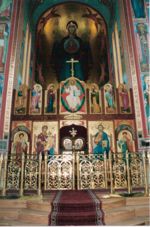Mother of God of the Sign
The icon of the Mother of God "Of the Sign" and is also known by various names, including Abalatskaya, Abalakskaya, and Abalat. The icon depicts a central panel with an icon of the Mother of God in an orans pose (prayerfully uplifted hands), and the Divine Infant, at her bosom, usually surrounded by a circular mandorla which represents the uncreated light and glory of God; in the left border is the figure of St. Nicholas of Myra and in the right border is St. Mary of Egypt. This icon is commemorated by the church November 27.
History
This depiction of the Mother of God is regarded as one of the very first of Her iconographic images. In the mausoleum of St. Agnes at Rome is a depiction of the Mother of God with hands raised in prayer with the Infant Christ sitting on Her knee, which is ascribed to the fourth century. There is also an ancient Byzantine icon of the Mother of God “Nikopea” from the sixth century, where the Most Holy Theotokos is seated upon a throne and holding in Her hands an oval shield with the image of the Savior Emmanuel.
Icons of the Mother of God, known as “The Sign,” appeared in Russia during the eleventh and twelfth centuries, and were so called because of a miraculous sign from the Novgorod Icon in the year 1170. In that year, the allied forces of Russian princes marched to the very walls of Novgorod. For the people of Novgorod, their only remaining hope was that God would help them. Day and night they prayed, beseeching the Lord not to forsake them. On the third night, Bishop Elias of Novgorod heard a wondrous voice commanding that the icon of the Most Holy Theotokos be taken out of the Church of the Savior’s Transfiguration on Ilina Street, and carried along the city’s walls.
While the icon was being carried, the enemy fired arrows at the procession, with one of the arrows piercing the iconographic face of the Mother of God. Tears trickled from Her eyes, and the icon turned its face towards the city. After this divine Sign, an inexpressible terror suddenly gripped the enemy. They began to strike one another, and taking encouragement from the Lord, the people of Novgorod fearlessly gave battle and won the victory.
In remembrance of the miraculous intercession of the Queen of Heaven, Archbishop Elias established a feast day in honor of the Sign of the Mother of God, which the Russian Church celebrates to the present day. Hieromonk Pachomius the Logothete, who was present at this festal celebration, composed two Canons for this Feast.
On other Novgorod Icons of the Sign, the miraculous events of 1170 were depicted. For 186 years afterwards, the wonderworking icon remained in the Church of the Savior’s Transfiguration. In 1356, it was transferred to a church built in Novgorod in honor of the Icon of the Most Holy Theotokos “of the Sign,” which became the Cathedral of the Monastery of the Sign.
Numerous copies of the Sign Icon are known throughout the world. Many of them were also glorified by miracles in local churches, and were then named for the place of the appearance of the miracle.
Source
- The Voice. Vol 6. No. 4 December 2006 "Spiritual Treasures of the Russian Diaspora: The miracle-working Abalak icon of the Theotokos “Of The Sign” in Holy Protection Church, Cabramatta, NSW"
- Commemoration of the Weeping Icon of the Mother of God "of the Sign" at Novgorod
See also
- The miracle-working Abalak icon of the Theotokos “Of The Sign” in Holy Protection Church, Cabramatta, NSW.
